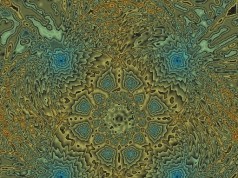QUANTUM: OBVIOUS YET ALL CHANGING
Quantum Physics is so natural that it embraces the fundamental organizing principle of superior human intelligence: “Il faut de tout pour faire un monde”.
It is continually said that Quantum Physics is “weird”. Maybe it is, but much less than any alternative previously imagined, such as Classical Mechanics. Classical Mechanics rest on a handful of strict “laws”. Instead, as we will see, the Quantum rests on just one very general principle, but, from there, enables the great freedom of spaces galore.
Indeed what is the most obvious alternative, between Classical and Quantum?
True, at first sight, the world looks classical. Yet, the classical vision, that the world made of points, is very naïve.
An analogy helps.
One need to go back to biology. Centuries ago, it was thought that a human being originated as an “homunculus”: a human being, just much much smaller. The truth turned out to be different: instead of keeping the same system of idea, genetics and molecular biology brought in completely new systems. The older ones are still around, but they were mostly displaced, or even partly completely replaced, by new systems of ideas.
Similarly, physicists, for centuries, thought that in the physical universe, the smaller one would look, the more one would see just the same thing, space-time with points, ever smaller. Could the small be like the big, just smaller and smaller?
That would have meant that there was no different explanation to the inner working of what we see. From what we see. Looking at the very small would not have provided with a different system of ideas (although looking at a smaller scale had provided with new systems in biology).
Such was the Classical Prejudice: smaller was not supposed to be any different. Yet plenty of phenomena were found that the “small is not any different” view could not explain.
And indeed, nature is not like that. First, Planck found that supposing that light energy was emitted in lumps explained two mysteries (Lord Kevin had called them “dark clouds”). Einstein then explained the photoelectric effect by the reception of light in lumps too.
Jumping further than he should have, he then proposed the hypothesis of “lichtquanten”.
Where did those Planck-Einstein lumps, those “Quanten” come from?
The most natural explanation was waves. In a constrained space, stable waves happen only at some frequencies. This explanation appeared with Bohr, in the constrained spaces around atoms, and was generalized with De Broglie’s Wave Principle”:
“To any particle is associated a guiding wave”.
At that point, Quantum Physics was essentially done: if it was all about waves, the uncertainty principle was obvious.
Next one had to define what a “wave” could be. Well, something given by a wave equation (what else?). Notice the difficulty: wherever we look, it’s not obvious what a wave is (just rolling out the second order partial differential equation used for bow strings will not do; although that works for that, does not make it a general principle, as we are going to see!)
The De Broglie(-“Schrödinger”) equation was just the most obvious candidate, but others appeared, like the relativistic Klein-Gordon.
Dirac rolled out the most general, simplest wave equation, the square root of the most obvious relativistic wave. That first order Dirac equation required a new space, Spinor Space (discovered independently much earlier by the mathematician Elie Cartan in 1913). It predicted a new particle: the anti-electron.
So Quantum Physics is actually the simplest imaginable logic to organize Nature as we have observed it. It’s not “weird”, it’s enlightening.
Notice that I implicitly solved the “Measurement Problem”: the concept of wave is, well wavy, fuzzy (actually, Quantum Waves penetrate walls, to some extent). So we cannot be sure that the “wave-function” we have are really perfectly defined, as a depiction of all what “reality” is, to START WITH (actually there are non-linear, arbitrarily close approximations of the “Schrödinger” equation).
Actually the history of Quantum Physics (and QFT) is a succession of wild guesses about what the wave equations could be. A few of these guesses worked, most of them did not (in many cases because non-linear effects had been neglected, such as “Normalization”).
De Broglie’s “Guiding Wave” class of theories was rejected (erroneously, it turned out) by some arrogant mathematicians. However, very recent experiments showed that some basic Quantum behavior can be duplicated experimentally with waves in fluid mechanics.
Bohm’s approach is just the PARTICULAR case of De Broglie’s general approach; as Bohm was born in the USA, the Anglosphere refers to him, but it’s truly De Broglie who invented the whole thing.
Reintroducing particles, as Bohm does, is throwing the baby with the bath. The bath, and the baby, are made of waves. Nobody said that they have to be linear.
(David Bohm, a physics professor at Princeton, USA born, was thrown out of the USA for. thinking. He was the first one to say that his 1953 theory was just part of De Broglie’s ideas. Bohm pursued his career in Brazil, and then England. In the late 1950s, he discovered the “Bohm-Aharanov effect”, the major fact that potentials were central to Quantum Physics, the very foundation of so-called “Gauge Theories” of Quantum Field Theory. )
And the Quantum is waving out there in many ways, in many spaces, some infinite dimensional. That’s the best realism we have.
It’s more fundamental than space and time, as we classically know them.
The classic picture of the universe was naïve. The Quantum vision changes everything. It provides us with enormously powerful new systems of ideas. It is intrinsically not just multidimensional, but, one could say, multiversal.
Common French wisdom has long proclaimed that :”Il faut de tout pour faire un monde” (One needs everything to make a world”). Philosophical systems embracing this principle are the most opposed to intellectual fascism. Intellectual fascism is the organization of one’s view of reality around a handful of axioms: religious fanaticism for a superstition is the archetype example.
Societies where Il faut de tout pour faire un monde are the most inclusive, and those were the open market of ideas can produce. They allow to make better ideas blossom, and bad ideas fade away.
It is comforting to know that Physics, deep down inside, works just the same.
To each context, its universe, yet, out of many, just one. It takes everything, including all sorts of spaces, to make a world. This is what the Quantum proudly proclaims.
Patrice Ayme






